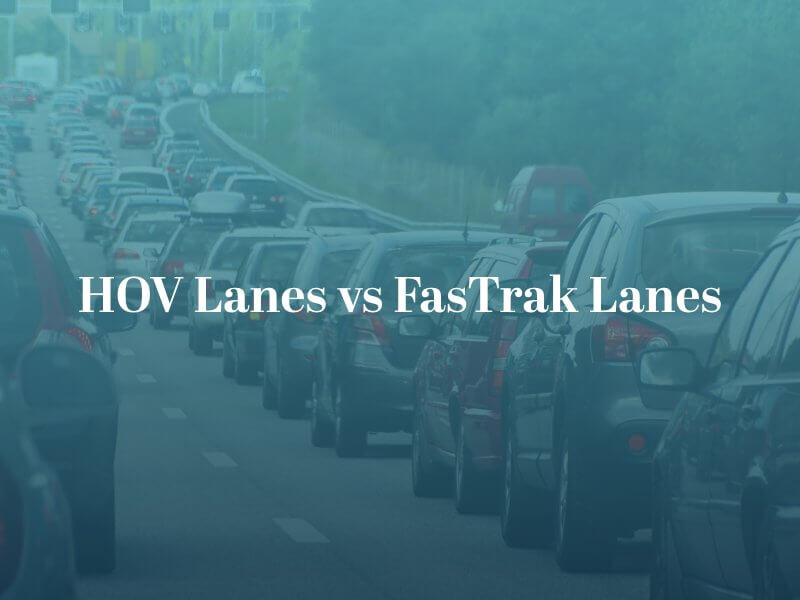Updated May 2, 2024
People new to California often call it a “car state.” This nickname stems from the fact that cities in California sprawl out over many miles rather than existing in small, concentrated areas with buildings built upward rather than outward, which is more common in East Coast cities. California’s size and urban sprawl require most residents to own cars. Unfortunately, this often means congested traffic and a tangle of different lanes with specific rules for properly using each. If you’ve been involved in an accident, contact a reputable Encino car accident attorney who can provide you with expert legal guidance.
If you’re new to driving in California, you may find some of the state’s marked lanes on busy highways confusing. Many new drivers or those new to Golden State ask, “What is the difference between the HOV lane and the Fastrak lane in California?”

High Occupancy Vehicle Lanes (HOV) are clearly marked on California highways. Also called carpool lanes and diamond lanes, HOV lanes help to encourage ridesharing, reduce traffic volume, and improve air quality. The HOV lane is typically an inside lane on the left, marked with periodic overhead signage and diamond symbols painted on the road surface.
HOV lanes in Northern California are open to all traffic during off-peak hours but on Monday through Friday during high-traffic hours, the lane is reserved for carpooling vehicles carrying two or more passengers.
In Southern California, HOV lanes are in full-time operation, meaning only vehicles with two or more passengers may use the lane at all times. Most HOV lanes in Southern California include protective buffer zones. Some HOV lanes in Southern California require vehicles using the lane to carry three or more passengers, so it’s important to look at the directions on the signs in the area you’re navigating.
Electric and hybrid vehicles are exempt from the requirement to carry additional passengers in HOV lanes in some areas, so be sure to check the laws in your location. Violating California’s HOV lane requirements may result in fines of a minimum of $450 and higher penalties for repeat offenders.
Fastrak lanes are limited-use roadways common in California’s Orange County, including on State Route 73, and S.R 133, 241, and 261. These routes are not a part of California’s public roadways but are managed by the Transportation Corridor Agency. FastTrak use requires a transponder placed inside vehicles to automatically pay the tolls required to use these limited routes or to drive in express lanes. Express lanes are marked with signs and require a fee. By using a FasTrak transponder, the fees are automatically charged to the user’s account.
Some express lanes are marked as High Occupancy Toll (HOT) lanes. These may be open to single occupancy vehicles with FasTrak accounts during peak hours and non-FasTrak users during off-peak hours. During these times, overhead signs indicate to drivers that the lane is open to all users. Vehicles that travel under 55mph cannot use the HOT lanes.
All 25 toll routes in California now require FasTrak accounts for payment. The FasTrak roadways allow residents to skip high-traffic areas and enjoy all 25 toll roads and bridges throughout the state as well as the Express lanes through automatic payments that don’t impede traffic the way toll booths do in other states.
California residents and visitors new to driving in the state must familiarize themselves with the rules for safely and legally using HOV lanes to avoid traffic violations and penalties. The California Highway Patrol (CHP) determines the penalties for traffic infractions such as HOV violations. According to CHP, their goal is to keep the rate of HOV lane violations at less than 10% of traffic using the lane. They enforce this goal by applying penalties to violators. Typically, local law enforcement notifies CHP when they find a high violation rate in a particular area and ask for heightened enforcement in that location, generating more traffic stops, citations, and penalties for infractions. Common HOV violations include the following:
HOV traffic violations come with a significant fine of $490. The county where the infraction occurred could impose additional fees.
FasTrak closely monitors traffic for violations, particularly in favored areas such as California’s iconic Golden Gate Bridge. Common FasTrak violations include the following:
Citations include the toll cost plus a $25.00 penalty. If the violator fails to pay the fee and penalty and receives a delinquent notice, the penalty increases to $70.00. Failing to pay after a second notice not only increases the penalty but also a notification to the DMV to withhold the violator’s vehicle registration. FasTrak may also engage a collection agency.
If you believe your citation was issued in error, there are several viable defense strategies to contest the citation. For HOV citations, attorneys often assert the following common defenses:
Proving the infraction didn’t occur could involve proving a CAV decal is valid, the driver didn’t enter the lane at a double solid line, or that they had sufficient passengers.
FasTrak toll evasion notices include a “Contest of Notice” section drivers may fill out and include their explanation or the reason they believe the notice is in error. FasTrak investigates the circumstances and responds within a few weeks. If FasTrak still maintains the evasion notification is accurate, drivers may request an administrative review of the situation within 60 days of receiving the results of the first investigation. Finally, drivers may file for an appeal in municipal court if FasTrak upholds their initial assessment of the citation after the administrative review.